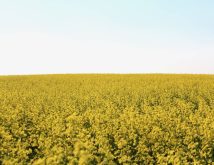SOUTHWEST
Little to no rain fell over the past week, with some scattered showers on the weekend. Above-average temperatures have producers seeding about a week earlier than normal – currently, pulse and wheat crops. Seeded acres are still low, with several areas of the region planning to start this week. Most winter crops and hay land have been fertilized. Winter wheat is progressing well and producers will be looking at weed control next. Winter annuals and spring weeds are growing with several producers starting weed control. Pastures and hay land are growing but could use precipitation.
Read Also

Manitoba Ag Days plans star-studded speaker lineup
Dragons’ Den panellist Arlene Dickinson among speaker series highlight for 2026 Manitoba Ag Days in Brandon, alongside slate of agriculture experts.
NORTHWEST
Most of the region had no precipitation, with only minor amounts in localized areas. Early-week daytime temperatures throughout the region were at or above normal, with nighttime temperatures below or just above 0 C. With the good conditions, cereal seeding is underway in all areas, as are spring field operations and fertilizer applications. In some parts of the region lower soil moisture levels are a concern. Pastures and hayfields are in fair condition.
CENTRAL
Above-normal temperatures and no significant precipitation have allowed for good seeding progress. Producers in eastern areas are now waiting for wetter areas to dry before continuing to seed. Subsoil moisture is good. The soil surface is dry with some seed and fertilizer sitting in dry soil. Precipitation would be welcome for even germination and emergence.
Seeding of cereal crops ranges from 10 per cent complete in the Carberry/ Gladstone areas and 35-60 per cent in the Somerset/Morden/ Altona/Starbuck/Portage areas to 80-90 per cent around Carman/ Morris. The earl iestseeded cereals are starting to emerge. Canola acres range from five to 10 per cent complete in much of the region, up to 50-60 per cent; this week will see many more acres go in. Five to 10 per cent of potatoes are in. Seeding of flax and sunflowers has begun. The odd corn and soybean field has been seeded. Some producers are holding off on seeding frost-sensitive crops while others take advantage of favourable field conditions. Winter wheat is progressing well; fertilizer application is complete.
Dry weather has allowed for overwintered corn to be harvested, some in relatively good condition.
Dugouts are in good shape. Pastures, hay and alfalfa fields are greening up. Weeds such as winter annuals, volunteer canola, dandelions, curled dock, quackgrass and volunteer cereals and wild oat are starting to show up.
EAST
No precipitation all week created ideal seeding conditions for many producers. Soil seedbed conditions are rated as good to very good. Flooding of the Red River this spring is causing delays for some producers. Excess moisture and cleanup of debris (straw, trees) is delaying seeding in some fields. Seeding of cereal crops ranges from 50 per cent complete in the Dugald area to 100 per cent complete. Some producers have 25-40 per cent of canola acres already seeded; others are waiting to resume seeding with oilseeds this week. The Arnaud area has about 2,000 acres of soybeans seeded. Some corn acres were planted. Winter wheat fields are greening up and are rated as good. Hayfields and pasture conditions are also rated fair to good, with little evidence of significant growth thus far. Rain would be welcomed for crops and pastures. Weeds such as wild oats, stinkweed and dandelions are emerging.
INTERLAKE
Warm-dry conditions continued through the week. Daytime soil temperatures range from 7 to 13 C; soil moisture conditions are excellent. Seeding progress in the south Interlake ranges between 30 and 65 per cent complete, predominantly in cereal crops and canola. Many producers are waiting to seed canola; north Interlake producers are just getting started. Seeding activity should be general later this week, weather permitting. Winter wheat crops look good throughout the south Interlake. Some growers have delayed broadcasting nitrogen fertilizer until a firm forecast for precipitation occurs. Hay and pasture conditions are excellent. Fertilizer application on forages is ongoing throughout the region. Forage seed crops are in good condition, with good winter survival.














